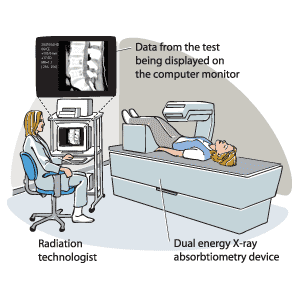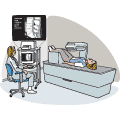Description of the test
Making sure your bones are strong and healthy is a common concern for men and women as we age. A bone mineral density (BMD) scan is a non-invasive, pain-free test that examines the density of your bones. It tells you whether your bones are weak (low density) or strong (high density).
A dense bone would be like a giant straw filled with sand - with very small spaces between each grain of sand. A low density or porous bone would be like a giant straw filled with rocks - with large spaces between the rocks that make it less densely packed.
The test is used to diagnose osteoporosis (fragile bones prone to fractures) or your risk of developing it in the future. The test may also be used to monitor your progress if you are already being treated for osteoporosis.
How often should the test be performed?
This test is done as needed to check for weak bones or to evaluate how osteoporosis treatments are working. Your doctor will let you know how often you need this test.
Why is this test performed?
This test is used to screen for osteoporosis and to see how well osteoporosis treatments are working. This test is useful for people who:
- are over the age of 65
- have had a fragility fracture (fractures that occur from injuries that would not fracture a normal bone, such as falling)
- are taking certain medications, such as steroids, which can increase the risk of osteoporosis
- currently smoke or have high alcohol intake
- have low body weight or have had major weight loss
- have lost at least 4 cm in height (or at least 2 cm in the last year)
- have conditions that may increase their risk of developing osteoporosis
- may be at risk of developing osteoporosis for reasons not listed above
- are being treated for osteoporosis (to see whether the treatment is working)
Are there any risks and precautions?
The test is very safe, although it is not recommended for anyone who is pregnant or suspects that they may be pregnant. Exposure to radiation during the test is minimal. The bone mineral density test does not cause any side effects.
What happens during the test?
This test is normally done in a hospital, a diagnostic centre, or a doctor's office.
The BMD test is non-invasive (i.e., nothing is inserted through the skin or into a body cavity) and pain-free. Areas tested may include the lower part of your spine (also called the lumbar region), the upper part of the thigh bone near the hip joint, the wrist, the forearm, the finger, or the heel.
For most BMD tests, you will be asked to lie on a table while an X-ray detector moves above your spine and hip. You may have one or both sides of your body scanned. The detector measures the amount of radiation in the form of X-rays, which are able to pass through your bone. The denser (stronger) your bones are, the less radiation will be able to pass through. The test takes about 5 to 20 minutes.
How should I prepare for this test?
BMD tests require very little preparation. You only need to avoid wearing jewellery and metal objects or buttons. You may need to wear a hospital gown. Tell your doctor or the person doing the test if you have had a bone fracture in the area being scanned (this can artificially increase your score, making your bones appear thicker than they are) or a test involving barium or dye injections in the last 2 weeks (this can interfere with the test).
Tell your doctor or prescriber about all prescription, over-the-counter (non-prescription), and herbal medications that you are taking. Also tell them about any medication allergies and medical conditions that you may have. Ask your doctor or pharmacist whether you need to stop taking any of your medications before the test.
What can I expect after the test?
You can return to your normal activities immediately after the test.
Results
By comparing your results with those of other people, your doctor determines your T-score. The T-score is a calculation that lets you know how dense your bones are compared to the average for young healthy adults of your gender who are at their highest lifetime bone mass.
If you have a high amount of bone loss, your doctor will tell you, in standard deviation units (SDs), how much below "normal" you are. If your bone density is more than 2.5 SDs below normal, you will be diagnosed with osteoporosis. If your T-score is between 1 and 2.5 SDs below normal then this is a sign that you have osteopenia, meaning that you are at a higher risk for osteoporosis.
You may also be given a Z-score. This compares your bone density to that of people who are of the same age, race, sex, and weight as you. If this score is more than 2 SDs below the average, then you may be experiencing abnormal bone loss as a result of something other than aging or menopause. Your doctor will discuss further testing with you if necessary.
All material copyright MediResource Inc. 1996 – 2024. Terms and conditions of use. The contents herein are for informational purposes only. Always seek the advice of your physician or other qualified health provider with any questions you may have regarding a medical condition. Source: www.medbroadcast.com/procedure/getprocedure/Bone-Mineral-Density-Scan




